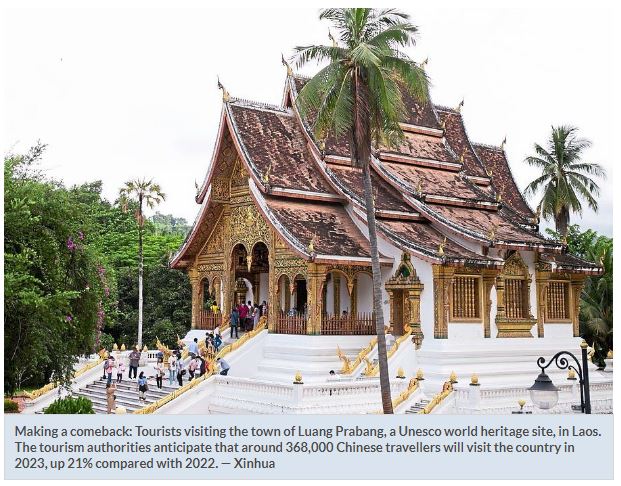Laos: Railway service a boon to economic recovery
VIENTIANE: The arrival of Chinese visitors is “a boon” for businesses that depend on tourism, says Noy Savanh, a food vendor at a night market in this capital city.
“Chinese tourists are valued guests in terms of their large number and strong spending power,” Noy said.
“I believe that the cross-border passenger service on the China-Laos railway will bring a lot more Chinese tourists to Laos and will be a strong boost to Laos’ economy and tourism,” she said, telling Xinhua that she is preparing for the arrival of Chinese travellers by learning some Chinese and providing Chinese menus.
Cross-border passenger service on the China-Laos railway will notably boost Laos’ tourism, the country’s top priority in revitalising its economy.
The tourism industry, a main source of foreign currency, has been viewed as a key sector to bolster the Lao economy, deputy head of the Prime Minister’s office Thipphakone Chanthavongsa has said at a meeting recently.
The meeting called for preparations for the planned start of cross-border passenger trains on the China-Laos Railway, which has become an important driver of the Lao tourism.
The first cross-border passenger service between the Lao capital Vientiane and Kunming, the capital city of southwest China’s Yunnan province, will be operational on April 13 ahead of the Lao New Year holiday, which falls on from April 14 to 16.
More than 200 Chinese tourists are expected to arrive in Laos on the first cross-border passenger train.
In February, director-general of the Tourism Development Department Phonemaly Inthaphome presented a draft plan on preparations for Chinese tourists, outlining the general situation and future outlook concerning the Chinese tourism market.
As the China-Laos railway becomes a crucial factor in facilitating travel, the Lao tourism authorities anticipate that around 368,000 Chinese travellers will visit Laos in 2023, up 21% compared with 2022.
The cross-border passenger train is a great advantage for Laos because it facilitates tourist travel, Bounthone Siphone, a vendor in VangVieng, a tourism town in Vientiane province, said.
Bounthone added that the arrival of Chinese tourists has brought hope to the recovery of the Lao tourism industry, as China is one of the world’s largest outbound tourism markets. He is confident that the return of Chinese visitors would boost his sales.
Also, some people are looking forward to taking a train to China when the cross-border passenger service starts operation.
“Curiosity about the train makes many Thai people decide to travel to the north of Laos. And Thai tourists will also be really interested in taking a bullet train directly to China,” Thanyart Areeyat, a tour guide from Thailand said at the Vientiane station in November last year.
Tourism experts predicted that millions of Chinese tourists will visit Asean countries and many of them would travel on the China-Laos railway.
Since the China-Laos railway came into operations in December 2021, it has seen an increasing demand for its services. From January to February, the railway of the Lao section carried 417,400 passengers, up 256.2% compared with the same period in 2022.
On the busiest days, the railway made a record by carrying 10,197 passengers a day.
As more passengers travel on the railway, the Laos-China Railway Company (LCRC) has launched its ticketing mobile application on March 15, allowing passengers to book and manage their journeys on mobile devices.
Meanwhile, the Lao government is taking steps to prepare for the start of the cross-border passenger service on the China-Laos railway to ensure safe and smooth travel of all visitors.
Lao deputy Prime Minister Saleumxay Kommasith travelled to Luang Namtha province last month to inspect work on the railway preparations.
Saleumxay instructed all relevant sectors, including the LCRC and the special economic zone in the region, to work together and ensure the new service operates as planned and runs smoothly.
The Lao government hopes to attract 1.4 million visitors in 2023, which is expected to generate more than US$340mil (RM1.5bil). — Xinhua


 English
English




